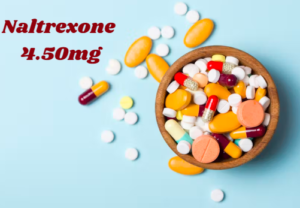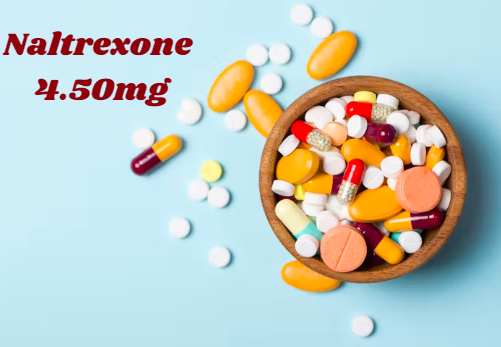Introduction
Naltrexone, a medication commonly used to treat alcohol and opioid dependence, has proven to be a valuable tool in addiction management. This guide explores the specifics of “naltrexone 4.50mg,” a lower-dose formulation that has gained attention for its potential benefits in various health conditions beyond addiction.
This article aims to provide a comprehensive understanding of naltrexone 4.50mg, its uses, benefits, mechanisms, and considerations, targeting readers in the USA.
What is Naltrexone 4.50mg?
A Brief Overview
Naltrexone is an opioid receptor antagonist that was originally developed to treat opioid addiction by blocking the euphoric and sedative effects of opioids. It has also been used effectively to manage alcohol dependence.
The standard dose for these purposes ranges from 50mg to 100mg per day. However, a lower dose of 4.50mg, often referred to as Low Dose Naltrexone (LDN), has been explored for a variety of other health conditions.
The Concept of Low Dose Naltrexone (LDN)
LDN is used at doses ranging from 1.5mg to 4.5mg per day. This low-dose regimen is thought to modulate the immune system and reduce inflammation, offering potential benefits for conditions like autoimmune diseases, chronic pain, and even certain cancers. The use of naltrexone 4.50mg in these contexts is still under research, but the anecdotal and preliminary scientific evidence is promising.
Mechanism of Action
Naltrexone and the Opioid Receptors
Naltrexone works by binding to opioid receptors in the brain, effectively blocking the effects of opioid drugs. At lower doses, this blockade is partial and temporary, which is believed to cause a rebound increase in endorphin production once the drug has cleared from the receptors. This increase in endorphins can help modulate the immune response and reduce inflammation.
Immune Modulation and Inflammation Reduction
The precise mechanism by which LDN exerts its effects on the immune system is not fully understood, but it is thought to involve the modulation of Toll-like receptors (TLRs), which play a critical role in the body’s immune response. By influencing these receptors, LDN may help to balance immune function and reduce pathological inflammation.
Clinical Applications of Naltrexone 4.50mg
Autoimmune Diseases
Multiple Sclerosis (MS)
LDN has shown promise in the management of multiple sclerosis, a chronic autoimmune disease affecting the central nervous system. Patients have reported improvements in symptoms such as fatigue, pain, and spasticity. Clinical studies have suggested that LDN may help to reduce the frequency and severity of MS relapses.
Crohn’s Disease
For individuals with Crohn’s disease, an inflammatory bowel condition, LDN has been reported to induce remission and reduce the need for corticosteroids and other immunosuppressive drugs. Small-scale studies have shown significant improvements in disease activity scores among patients using LDN.
Chronic Pain Conditions
Fibromyalgia
Fibromyalgia is characterized by widespread musculoskeletal pain, fatigue, and tenderness in localized areas. LDN has been studied as a potential treatment for fibromyalgia, with patients reporting reductions in pain and improvements in quality of life. The anti-inflammatory effects of LDN are believed to play a role in alleviating the symptoms of fibromyalgia.
Complex Regional Pain Syndrome (CRPS)
CRPS is a chronic pain condition that typically affects a limb after an injury. LDN has been explored as a treatment option for CRPS due to its potential to modulate the immune response and reduce inflammation. Patients have reported reductions in pain intensity and improvements in function.
Neurodegenerative Diseases
Parkinson’s Disease
Preliminary research suggests that LDN may offer benefits for individuals with Parkinson’s disease, a progressive neurodegenerative disorder. By modulating the immune system and reducing inflammation, LDN may help to slow the progression of the disease and improve motor and non-motor symptoms.
Alzheimer’s Disease
There is ongoing research into the use of LDN for Alzheimer’s disease, another neurodegenerative condition. While the evidence is still emerging, LDN’s potential to reduce inflammation and support immune function makes it a promising candidate for further study.
Safety and Side Effects
General Safety Profile
Naltrexone 4.50mg is generally well-tolerated, with a lower risk of side effects compared to higher doses used for addiction treatment. The most common side effects reported include sleep disturbances, vivid dreams, and gastrointestinal issues. These side effects are usually mild and transient.
Considerations for Use
It is important to note that LDN may not be suitable for everyone. Individuals with liver disease, acute hepatitis, or those taking opioid pain medications should avoid LDN. As with any medication, it is crucial to consult with a healthcare provider before starting LDN to ensure it is safe and appropriate for your specific health condition.
How to Obtain Naltrexone 4.50mg
Prescription Requirements
In the USA, naltrexone is available by prescription only. It is important to consult with a healthcare provider who is knowledgeable about LDN to obtain a prescription and appropriate guidance on its use.
Compounding Pharmacies
LDN is often prepared by compounding pharmacies, which can customize the dose according to the prescriber’s specifications. These pharmacies can create naltrexone in the 4.50mg dose needed for LDN therapy. It is important to use a reputable compounding pharmacy to ensure the quality and accuracy of the medication.
FAQs
What is the primary use of naltrexone?
Naltrexone is primarily used to treat alcohol and opioid dependence. However, in lower doses (4.50mg), it is being explored for various other health conditions such as autoimmune diseases and chronic pain.
How does naltrexone 4.50mg differ from higher doses?
Naltrexone 4.50mg, or Low Dose Naltrexone (LDN), is used at a much lower dose than what is typically prescribed for addiction treatment. At this lower dose, it is believed to modulate the immune system and reduce inflammation, offering potential benefits for a range of conditions beyond addiction.
Is naltrexone 4.50mg safe?
Naltrexone 4.50mg is generally considered safe and well-tolerated. Common side effects are mild and include sleep disturbances and gastrointestinal issues. However, it is important to consult with a healthcare provider before starting LDN to ensure it is safe for your specific health condition.
Can I take naltrexone 4.50mg if I am on other medications?
It is important to consult with a healthcare provider before starting LDN, especially if you are taking other medications. LDN may interact with certain drugs, particularly opioid pain medications, and may not be suitable for individuals with certain health conditions.
Where can I get naltrexone 4.50mg?
Naltrexone 4.50mg can be obtained through a prescription from a healthcare provider. It is often prepared by compounding pharmacies, which can create the specific dose needed for LDN therapy.
Conclusion
Naltrexone 4.50mg, or Low Dose Naltrexone (LDN), offers a promising alternative treatment option for a variety of health conditions beyond its traditional use in addiction management. By modulating the immune system and reducing inflammation, LDN has shown potential benefits for autoimmune diseases, chronic pain conditions, and neurodegenerative disorders.
While more research is needed to fully understand its mechanisms and efficacy, the preliminary evidence and patient reports are encouraging. As with any medication, it is essential to consult with a healthcare provider to determine if LDN is a suitable option for your specific health needs.




















+ There are no comments
Add yours